With the Bare Eye and with the Microscope
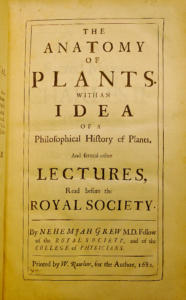
Fig. 1. Title Page, The Anatomy of Plants.
The subject of this month’s treasure is Nehemiah Grew (1641-1712). It seems appropriate, given his surname, that he devoted much time to the study of plants. Univ Library has a copy of his work The Anatomy of Plants. With an Idea of a Philosophical History of Plants, and several other Lectures, read before the Royal Society. Until 2023 it was on loan to the Museum of the History of Science, and it is a pleasure to be able to share this splendidly illustrated book with the Univ community. The plain binding and title page give no clues to the magnificence within.
Published in 1682 and illustrated with 83 plates, The Anatomy of Plants is a compilation of Grew’s botanical work and selected other lectures presented to the Royal Society from 1671 onwards. It is one of the first and greatest systematic studies of plant structures. By dedicating his studies to a specific area, Grew helped establish the science of botany as a distinct discipline. His work was translated into Latin and French, and it is said it was not surpassed for over a century. Grew’s contribution to science is acknowledged by Carl Linnaeus, who named the Grewia genus of trees in his honour.
The Anatomy of Plants presents Grew’s cumulative work in logical order, starting with An Idea of a Philosophical History of Plants, in which he sets out his pioneering plan for a thorough and systematic study of plant anatomy, “examining the Root, Trunk, Branch, Leaf, Flower, Fruit and Seed”. He noted that by carrying out a detailed study of some plants, inferences may be made about the structure of plants in general. “For in looking upon divers Plants, though of different Names and Kinds; yet if some affinity may be found betwixt them, then the nature of any one of them being well known, we have thence ground of conjecture as to the Nature of all the rest”.
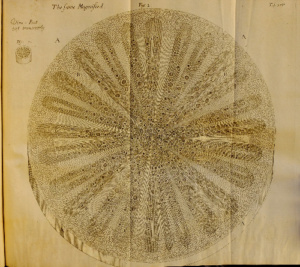
Fig. 2. “Vine root cut transversely” The Anatomy of Plants, Tab. 17.
Grew’s findings are set out as four books: The Anatomy of Plants Begun; The Anatomy of Roots; The Anatomy of Trunks and The Anatomy of Leaves, Flowers, Fruits and Seeds. There follow several other lectures which Grew read to the Royal Society, including A Discourse of the Colours of Plants and A Discourse of the Diversities and Causes of Tasts [Tastes] Chiefly in Plants.
The plant anatomy work is illustrated by Grew’s magnificent, detailed drawings, “prosecuted with the bare eye and with the microscope”. The cross-sections of roots and stems are particularly impressive, as shown here in this fold-out plate of a vine root.
Grew’s emphasis on comparing plants of different types to look for similarities is clear in the illustrations. He studied cross-sections of branches of several different tree species, including these comparing pine and oak.
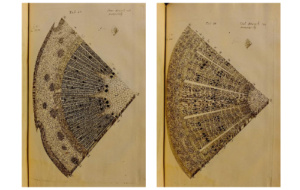
Fig. 3. Comparative sections of tree branches. On the left a pine branch (Anatomy of Plants Tab. 32) and on the right an oak branch (Anatomy of Plants Tab. 33)
An impressive aspect of some drawings Is the three-dimensional effect, as shown in this illustration of “Turpentine-Vessels in the Barque of pine” and “Milk-Vessels in the Barque of Sumach.”
Grew’s studies of roots and stems brought understanding that the vessels he identified carried fluids, although he saw this in analogy to the circulation of fluids in animals, rather than the processes of capillary action of transpiration.
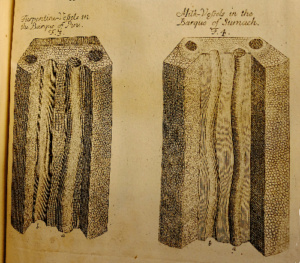
Fig. 4. The Anatomy of Plants, Tab. 20
Every plate is a delight to the eye and testament to Grew’s skill and patience as an illustrator. The sheer range of illustrations to accompany a scientific text is impressive. He even studied and drew pollen, and made a significant observation on the possible role of the stamens or “attire” of flowers in reproduction, a theory he confirmed through discussion with his peers. He writes “In discourse hereof with our Learned Savilian Professor Sir Thomas Millington, he told me, he conceived, That the Attire doth serve as the Male, for the Generation of the Seed”. Here is Grew’s drawing of the “attire” of a chicory flower. As in other illistrations, Grew used a technique, probably learned from Robert Hooke, of including a drawing of the entire subject to provide context for the highly magnified detailed views.
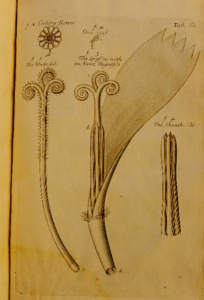
Fig. 5. “The Attire (of 3 Pieces) proper to each Leaf in the Flower of Cichory”. The Anatomy of Plants, Tab. 62.
Turning to the story of how Grew’s great work came about, it is an example of the sometimes precarious path of a long research project, and provides an insight into how the Royal Society (founded in 1660) attempted in its early years to support high quality science.
Nehemiah was the son of Obadiah Grew and Helen Sampson (née Vicars) from Warwickshire. He studied at Pembroke College, Cambridge, graduating with a BA in 1661. He is commemorated in the library there, with a stained-glass window based on his illustrations. His interest in botanical anatomy began in 1664, a year before publication of Robert Hooke’s Micrographia. He was inspired by anatomical studies of animals to apply the same principles to plants, something which had not been undertaken before. In the preface to The Anatomy of Plants Grew writes “being then newly furnished with a good stock of Seeds, in order to raise a Nursery of Plants; I resolved, besides what I first aimed at, to make the utmost use of them for that purpose”.
Not content with a spot of gardening, Grew embarked on his scientific studies. It is uncertain how he made his living at this time. Possibly it was by working as a physician around the Coventry area. His diligent work, mostly conducted without magnifying aids, first bore fruit in 1671. In 1670 his half-brother Henry Sampson brought Grew’s work to the attention of the Royal Society, which in May 1671 ordered it to be published as The Anatomy of Vegetables Begun. In the summer Grew took a Doctorate in Medicine from the University of Leiden, and on 16 November 1671 he was elected a Fellow of the Royal Society, proposed by Robert Hooke. Quite a year!
The printed book of The Anatomy of Vegetables Begun was presented to the Royal Society on 7th December 1671. At the same meeting there appeared a paper on a very similar subject by the more senior and established Italian microscopist Marcello Malpighi. Modestly, Grew considered terminating his research out of deference, but he was encouraged to continue by John Wilkins, Bishop of Chester. Wilkins persuaded Royal Society members to subscribe to a fund enabling Grew to move to London to continue his work. In January 1672, Grew read to the Society his Idea of a Philosophical History of Plants, which in effect was a research proposal for the completion of his great anatomical study.
By the summer of 1672, Grew was in London, his official position being Curator for the Anatomy of Plants. His years working at the Royal Society gave Grew access to better equipment, particularly a microscope, and he was advised and guided by Robert Hooke with whom he was on good terms. Grew corresponded with his Italian contemporary Marcello Malpighi and microscopy pioneer Antoni van Leeuwenhoek. He presented his work at meetings of the society, and published his work in books that were eventually brought together in The Anatomy of Plants. Grew’s research, therefore, has elements of the way science is practised today. He had financial support from a scientific body for a proposed and approved course of research, he regularly presented and published his work, and was in discourse with fellow scientists internationally.
There were, however, repeated problems with funding. Promised subscriptions did not materialise, not helped by the death of John Wilkins. Grew had left his medical practice to work at the Royal Society, anticipating that his plant anatomy work would take five years, but with scarcely funds to cover one year. In August 1673 Grew was back in Coventry, clearly frustrated by his financial situation. He wrote to Henry Oldenburg, secretary to the Society, stating “I shall be loath to stirr from Coventry, till I have further ground to believe the subscriptions will be made up, then yet I have had”.
Help came from Robert Hooke, who arranged for Grew to be deputy lecturer to Jonathan Goddard, Professor of Physic at Gresham College, for a salary of £40 per annum. Grew returned to London, yet experienced a further setback when Goddard died in 1675 and he lost the lectureship. He later secured another position, deputising for Walter Pope, the Gresham Professor of Astronomy. He received some payment for his Royal Society lectures, and it is plausible he also practised medicine. Grew had a little more security after September 1677, when he and Robert Hooke became joint Secretaries to the Royal Society, following the death of Henry Oldenburg. Grew also took on the job of cataloguing the Society’s collection of objects. In 1680 he became an Honorary Fellow of the College of Physicians, which boosted his status as a doctor. After the publication of The Anatomy of Plants in 1682, Grew’s research activity waned, possibly as his work as a physician increased. He still regularly attended meetings of the Royal Society, practised medicine and, as the son of a nonconformist minister, turned his intellect to spiritual matters. His last publication was Cosmologia Sacra, a detailed religious essay.
Although less celebrated than his scientific contemporaries, Nehemiah Grew deserves recognition as a pioneer for his greatest work, The Anatomy of Plants. Let us leave him to modestly take some credit in his own words. “There are Terrae Incognitae in Philosophy as well as Geography. And for so much, as lies here, it comes to pass, I know not how, even in this Inquisitive Age, That I am the first who have given a Map of the Country”.
Bibliography
Grew, N. (1641-1712). The Anatomy of Plants. With an Idea of a Philosophical History of Plants, and several other Lectures, read before the Royal Society. London: W. Rawlins, 1682). D.105.15
References
Bolam, J., Jones, R. V., & Paton, W. D. M. (1973). The botanical works of Nehemiah Grew, F. R. S. (1641-1712). Notes and Records of the Royal Society of London, 27(2), 219-231. https://doi.org/doi:10.1098/rsnr.1973.0017
Dev, R., Kannan, V., Kumar, M.S., Dayal, D., Patel, R. (2019). Grewia Species: Diversity, Distribution, Traditional Knowledge and Utilization. In: Mariod, A. (eds) Wild Fruits: Composition, Nutritional Value and Products. Springer, Cham. https://doi.org/10.1007/978-3-030-31885-7_31
Hunter, M., Jones, R. V., & Paton, W. D. M. (1982). Early problems in professionalizing scientific research: Nehemiah Grew (1641-1712) and the Royal Society, with an unpublished letter to Henry Oldenburg. Notes and Records of the Royal Society of London, 36(2), 189-209. https://doi.org/doi:10.1098/rsnr.1982.0011
Hunter, M. (2015, May 28). Grew, Nehemiah (bap. 1641, d. 1712), botanist and physician. Oxford Dictionary of National Biography.
Kit Smart’s Blog. What a Pane. Retrieved 15 Feb. 2024, from https://www.pem.cam.ac.uk/kit-smarts-blog/what-pane (Kit Smart is the Pembroke College cat).
Mackenzie, P. (2022). Nehemiah Grew, the illustrator. Notes and Records: the Royal Society Journal of the History of Science, Published ahead of print. https://doi.org/doi:10.1098/rsnr.2022.0020
